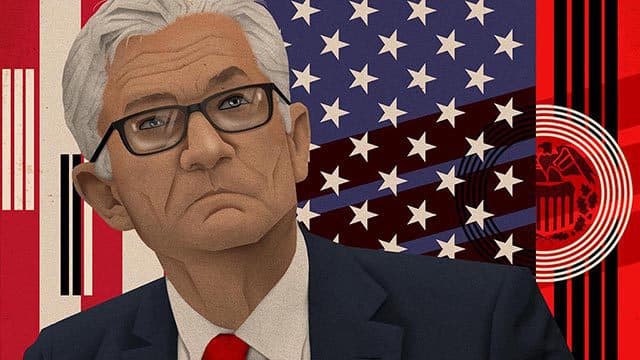Jerome Powell Secures Second Term as Inflation Persists
President Biden renominated the Fed chair, providing policy continuity, while Powell’s chief rival, Lael Brainard, will take on the Vice Chair spot.

Jerome Powell, chair, Federal Reserve, Blockworks Exclusive Art by Axel Rangel
- Chair Powell will have the opportunity to see his policy prescriptions play out for another four years at the Federal Reserve
- President Biden and Treasury Secretary Yellen both saluted Powell’s economic stewardship
Jerome Powell, whose four-year term expires in February and who led the Federal Reserve through the Covid-19 crisis, has been nominated for a second term, President Joe Biden announced Monday morning.
Prior to the announcement, there was speculation that Fed Governor Lael Brainard might be selected to lead the central bank, however President Biden instead selected Brainard as the vice chair of the board of governors. Both nominations will now head to the Senate for approval.
“While there’s still more to be done, we’ve made remarkable progress over the last ten months in getting Americans back to work and getting our economy moving again,” President Biden said in a statement.
“I’m confident that Chair Powell and Dr. Brainard’s focus on keeping inflation low, prices stable, and delivering full employment will make our economy stronger than ever before.”
Powell was nominated to the Fed board of governors by President Obama, then picked as Fed chair in 2017 by President Trump, succeeding Janet Yellen, the current Treasury Secretary.
“An independent and experienced Federal Reserve was critically important to navigating this turbulent time and will continue to be crucial as we recover and confront new threats to our economy,” Yellen said in a written statement following the announcement. “Over the past few years, Chair Powell has provided strong leadership at the Federal Reserve to effectively meet and address unexpected economic and financial challenges, and I am pleased our economy will continue to benefit from his stewardship.”
If approved, Powell faces a challenging second term as head of the central bank.
With a 6.2% annual rate of inflation from October 2020 to October 2021, Inflation is running hotter than it has in decades. Unemployment and supply chain issues fueled by the greatest public health crisis of the century continue to persist with no clear end in sight. The Fed has had its credibility called into question in the wake of governors Robert Kaplan and Eric Rosengren’s scandalous trading practices.
Powell announced earlier this month that the central bank will begin to taper its current asset purchasing rate, which has been $120 billion per month since June 2020. The tapering, which some economists called for months ago, will be broken down as a $10 billion reduction in Treasuries and a $5 billion reduction in mortgage-backed securities.
The committee decided to begin tapering in this way “in light of the substantial further progress the economy has made toward the Committee’s goals since last December,” the Federal Open Market Committee said in its post-meeting statement.
Powell was careful to maintain his stance that supply chain issues and bottlenecks will persist well into 2022 in his tapering announcement.
Bitcoin and other digital assets spiked over 4% as the news broke Monday morning in New York, but have since given up most of those gains.
Get the day’s top crypto news and insights delivered to your inbox every evening. Subscribe to Blockworks’ free newsletter now.






